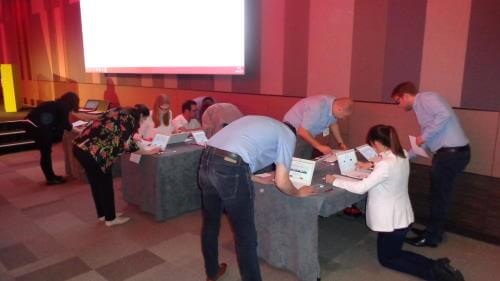Remote team building wasn’t required when we started back in 1992 – yes, we’ve been around a while!
Back then, we had an office. A real one. That everyone worked from. Every day. Home working was only really for consultants and other small businesses in the early 1990s. Global virtual teams didn’t really exist. If they did, no one told us about them anyway. So remote team building wasn’t required. When we worked with geographically spread teams, their members came together and we worked with them in person.
Now, of course, things are very different. We’re a remote team ourselves. But we became one before we started to offer remote team building for other such teams. We don’t need to practice what we preach. Our online business these days came about more as a way to preach what we were already practising!
From learning and development to in-person team building
We started life as a learning and development company, providing mostly long-term development courses for managers and teams. Most of these were either for locally based clients or for other locations (including international ones) connected with those clients. Our Unique Selling Point (USP) in those days was all to do with participant engagement within the courses that we ran.
Our rationale was that it didn’t matter how good the messages were that we were trying to put across to our participants if they were asleep. We wanted them to enjoy the learning process. That way, they would far better assimilate the learning on offer. It’s why, even then, we called the people on our courses “participants”. Other training providers called theirs either “delegates” or “attendees”. Ours participated in a two-way process throughout each and every session that we ran.
To facilitate this, at the start we used commercially available experiential exercises to engage people. They helped us stand out from the crowd, but we felt that there was room for improvement. So, we started creating our own in-person activities.

Technology keeps our in-person events smooth whatever the group size
Because we could, we created them using technology as a way to deliver them. And they took on a life of their own. Our clients loved that they delivered relevant learning and that they got great feedback from the participants. Clients started to ask us to run them at stand-alone events – company conferences, team away days and the like. We started to advertise our services for team building. And that’s when things really took off for us. Team building became our mainstream business.
Our events became popular both nationally and internationally. As our business grew, so did the number of people involved in delivering them. And our people were now spread nationally as well.
We’d become a remote team.
From in-person team building to remote team building
Using technology to deliver great event smoothly and seamlessly – however small or large the group size – we always wanted to make something available online. For the first few years, though, we were just too busy to do anything about it.
Once we had grown our in-person activity portfolio to a good size, though, we decided to prioritize developing our first online remote team building option – Space Rescue. It was ready for launch and went live in 2008. Within a short space of time it took off – please excuse the pun! At a time that budget was at a premium (thanks for the financial crisis), a professional team building activity that didn’t require geographically spread team members to come together to tackle a challenging and learning-focused remote team building activity was of great interest to many organizations. Initially, we were running sessions for teams of fewer than 10 people. But quickly that grew and soon our largest group size was in a little over 1,200 people.
Now our largest group size is in excess of 7,000 people. The great thing about using technology as the delivery mechanism is that it is infinitely scalable. We have no doubt that we’ll be running for even larger groups at some point in the not-too-distant future.
All because we are a remote team ourselves?
All? No. But a significant part certainly is. In expanding our portfolio we were able to call upon our own direct experience of being a remote team. But we also used various outside sources such as this Harvard Business Review article titled Getting Virtual Teams Right. Even today, new research and articles that focus on newly formed remote teams thanks to Covid-19 such as this shown on a BBC site is essential reading for us.
We may already preach what we practice, but we want to improve our own remote team’s happiness and effectiveness as much as we want to continue to help our clients’ remote teams.

